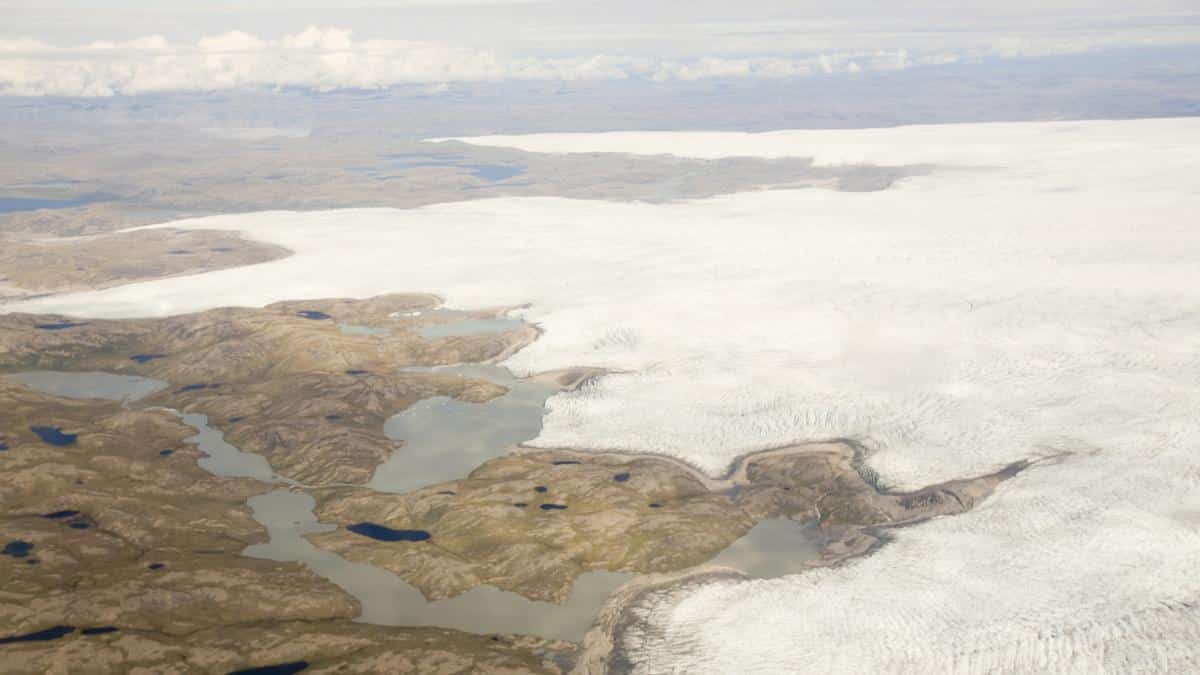

The western edge of the Greenland ice sheet in West Greenland as seen from the air. Ashley Cooper / Getty Images
As the world’s ice sheets melt at an increasing rate, researchers are looking for explanations beyond just a hotter climate. A recent study found one answer may lie in the dust.
Published on Monday in Nature Communications, the study found that phosphorus, a mineral found in dust, is a key nutrient for an extensive glacier algae bloom on Greenland’s ice sheet, known as the “dark zone.” As the algae grow, the ice becomes darker, decreasing its ability to reflect sunlight and causing the ice to melt faster and sea levels to rise.
“It’s important to understand the controls on algal growth because of their role in ice sheet darkening,” Dr. Jenine McCutcheon, who led the study published in Nature Communications, told the University of Leeds. “Although algal blooms can cover up to 78 percent of the bare ice surfaces in the Dark Zone, their abundance and size can vary greatly over time,” Dr. McCutcheon added.
Since 2000, the dark zone’s melting season has “progressively started earlier and lasted longer,” according to the University of Leeds. Glacier algal blooms are responsible for up to 13 percent of surface melting in this region, the study noted.
But until recently little was known about how these algal blooms developed.
Researchers found that phosphorus can cause the photosynthesis rate of the ice algae to improve significantly, McCutcheon said, according to the University of Leeds.
Although researchers examined dust sourced from local rock, they warned that dust can be transported thousands of miles by the wind.
“As dryland areas in northerly latitudes become even drier under climate change, we can expect to see more dust transported and deposited on the Greenland Ice Sheet, further fueling algal blooms,” Associate Professor Dr. Jim McQuaid, who co-authored the study, noted.
“The findings of this study will improve how we predict where algal blooms will happen in the future, and help us gain a better understanding of their role in ice sheet albedo reduction and enhanced melting,” Dr. McCutcheon added.
Researchers are also asking how these algal blooms will grow and darken in a warming climate.
“In 2019 our glaciers and ice sheets [are] already being darkened by dust, soot, and ash from our industrial world, which provides the perfect home for algae to flourish,” Alexandre Anesio, a professor in Arctic biogeochemistry from Aarhus University, who was not affiliated with the University of Leeds study, told The Guardian. “As the organisms reproduce, they melt even more snow, which in turn allows them to proliferate again. So it’s like a cycle. A very bad one.”
Darkening ice is not just occurring on Greenland’s ice sheets, according to The Guardian. It’s happening globally, Professor Liane Benning of the German Research Center for Geosciences noted, also impacting the Alpine and Himalayan glaciers.
In Western Canada, wildfires fueled by climate change are also leaving ash on glaciers, staining the ice, creating habitats for algae and “accelerating the warming process in a feedback loop,” Reuters reported.
“To be honest, I’m massively worried,” Anesio told The Guardian. As the planet warms, researchers are rushing to find answers on glacial melting and its impact on biodiversity.
“I just hope that we are not crossing that tipping point because I don’t think humans can adapt to the rates of changing climates at the moment,” Anesio added.
- Mangroves Threatened by Sea Level Rise Could Disappear by ...
- Louisiana Faces Faster Levels of Sea-Level Rise Than Any Other ...
- Worst Case Sea Level Rise by Century's End Could Be Doubled ...
- Wildfires Could be Pumping 3x More Soot to the Arctic Than Previously Thought, New Study Finds - EcoWatch

 233k
233k  41k
41k  Subscribe
Subscribe 